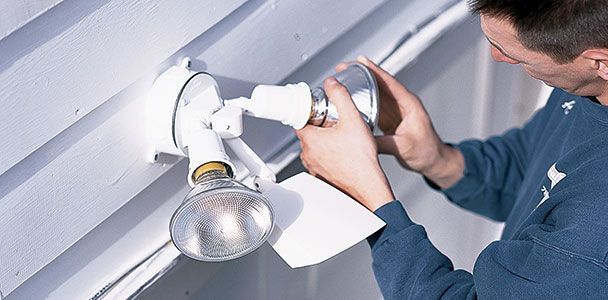Project details
Skill
Cost
Estimated Time
One of the simplest, most effective ways to improve your home’s security is by adding a motion-sensor floodlight to the garage. With motion sensor capabilities, these lights automatically illuminate when someone approaches, deterring potential intruders and providing convenient lighting for you and your family.
This guide will walk you through the process of installing a garage floodlight, from selecting the right fixture to final adjustments.
Types of Garage Floodlights
Garage floodlights provide broad illumination for driveways, walkways, and the area surrounding your garage, enhancing visibility and safety. There are several types of garage floodlights available, each with its own benefits:
- LED floodlights: Energy-efficient and long-lasting, LED floodlights are becoming increasingly popular for outdoor lighting. They offer bright illumination with minimal energy consumption, making them a cost-effective choice in the long run.
- Halogen floodlights: These provide bright, white light but consume more energy than LEDs. They’re often used in applications where intense, directional lighting is required.
- Solar-powered floodlights: Ideal for areas without easy access to electrical wiring, these lights charge during the day and operate at night. They’re an eco-friendly option that reduces dependency on the electrical grid.
- Smart floodlights: These can be controlled via smartphone apps and often integrate with home automation systems. Smart floodlights offer additional features such as remote activation, scheduling, and real-time alerts.
Benefits of Motion-Sensor Floodlights
Motion sensor floodlights offer several advantages:
- Energy efficiency: Lights only activate when needed, saving electricity. This targeted use of lighting prevents wasting energy and reduces utility bills.
- Security: Sudden illumination can startle and deter potential intruders. The immediate light presence can make would-be trespassers think twice before approaching.
- Convenience: Automatic activation provides hands-free lighting when approaching your garage, offering practical benefits when your hands are full or when it’s dark.
- Customization: Many models allow you to adjust sensitivity and duration of illumination. This lets you tailor the floodlight to your specific needs and preferences.
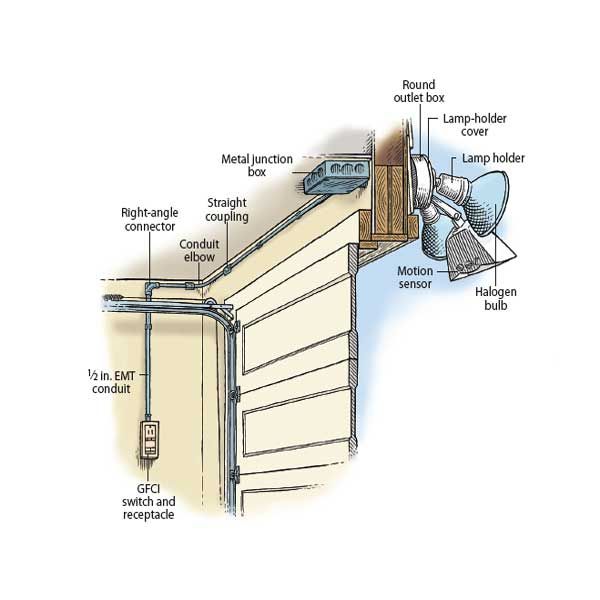
Planning Your Floodlight Installation
Before beginning the installation process, you need to assess your garage’s electrical setup and choose the right floodlight for your needs. If you’re not comfortable working with electricity, you should call a professional instead.
Assessing Your Garage’s Electrical Setup
Start by examining your garage’s existing electrical system:
- Locate the electrical panel and identify the circuit that powers your garage.
- Check if there’s an available outlet near your desired installation location.
- Determine if you need to run new wiring or if you can tap into existing circuits.
- Consider hiring an electrician if you’re unsure about your garage’s electrical capacity or if significant rewiring is needed. Professional evaluation can prevent potential electrical hazards.
Choosing the Right Floodlight
Selecting the appropriate floodlight depends on several factors:
- Coverage area: Measure the space you want to illuminate to determine the required light output. This ensures that the chosen floodlight provides adequate lighting for the intended area.
- Power source: Decide between hardwired or plug-in models based on your garage’s setup. Hardwired models are more permanent, while plug-in models offer flexibility.
- Features: Consider options like adjustable heads, multiple lamps, or smart connectivity. These features can enhance the functionality and usability of your floodlight.
- Design: Choose a style that complements your home’s exterior.
Gathering Necessary Tools and Materials to Install Floodlights
Gathering all the required tools and materials before you begin will help ensure a smooth process and minimize interruptions.
Tools for Installation
Here’s a list of tools you’ll likely need:
- Drill and drill bits
- Screwdrivers (flathead and Phillips)
- Wire strippers and cutters
- Voltage tester
- Level
- Measuring tape
- Ladder or step stool
 Linesman pliers
Linesman pliers Wire strippers
Wire strippers Magnetic torpedo level
Magnetic torpedo level Spade bit, 7/8 inch
Spade bit, 7/8 inch Tape measure
Tape measure Phillips screwdriver
Phillips screwdriver Drill/driver
Drill/driver Ladder
Ladder Fish tape
Fish tape Hacksaw
Hacksaw Round file
Round file Utility knife
Utility knife
Required Electrical Components
In addition to the floodlight itself, you’ll need:
- Electrical box (if not already present)
- Wire connectors (wire nuts)
- Electrical tape
- Conduit and conduit fittings (if running new wiring)
- 14/2 nonmetallic cable (Romex)
- GFCI receptacle and switch (if replacing an existing outlet)
Safety Precautions Before Floodlight Installation
Safety should be your top priority when working with electricity. Always adhere to safety guidelines to protect yourself and your property.
Turning Off Power to the Garage
Take these steps before starting any electrical work:
- Locate your home’s main electrical panel.
- Identify the circuit breaker that controls power to your garage.
- Switch off the appropriate breaker.
- Use a voltage tester to confirm that power is off at the installation site. This step is vital to avoid electrical shocks.
Proper Use of Electrical Testing Equipment
A voltage tester can help ensure your safety. Here’s how to use it:
- Always test the tester on a known live circuit before use. This ensures the tester is functioning correctly.
- Check both hot and neutral wires to confirm power is off. Verifying both wires provides an extra layer of safety.
- Recheck periodically during installation to ensure power remains off. This continual checking helps maintain a safe working environment.
Preparing the Garage Floodlight Installation Site
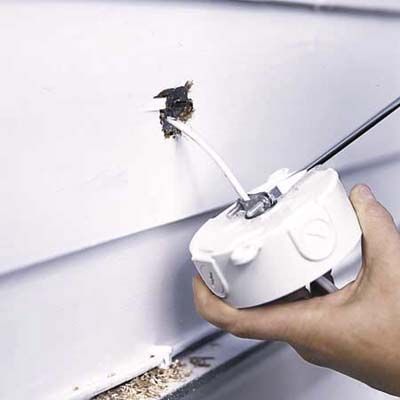
Before starting installation, you’ll need to choose the best location for the floodlight and prepare the mounting surface.
Selecting the Optimal Location
Consider these factors when choosing where to install your floodlight:
- Height: Install the light high enough to cover the desired area, typically 8 to 10 feet above the ground. This height provides optimal coverage and security.
- Angle: Ensure the light can be aimed to cover the intended area without causing glare or light pollution. The right angle maximizes effectiveness while being considerate of neighbors.
- Accessibility: Choose a location that allows for easy maintenance and bulb replacement. Easy access simplifies future upkeep.
- Proximity to power: Select a spot near an existing power source if possible. This reduces the need for extensive wiring.
Marking and Drilling Mounting Holes
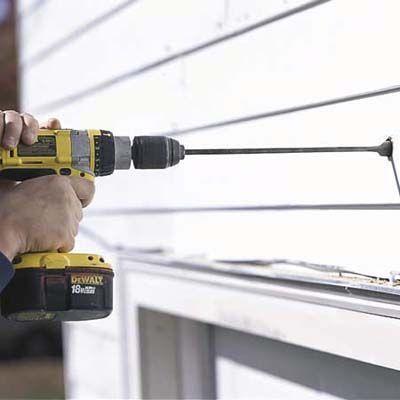
Once you’ve chosen the location, take these steps:
- Use a level to mark the position of the mounting holes. Ensure the marks are level for a professional installation.
- Drill pilot holes for the mounting screws. Pilot holes make it easier to insert screws and prevent splitting the mounting surface.
- If mounting on siding, use a siding block to create a flat surface for installation. This step provides a stable base for your floodlight.
Installing the Electrical Box for the Floodlight
The electrical box serves as the connection point between your home’s wiring and the floodlight. Proper installation ensures a safe and secure electrical connection.
Attaching the Extension Box
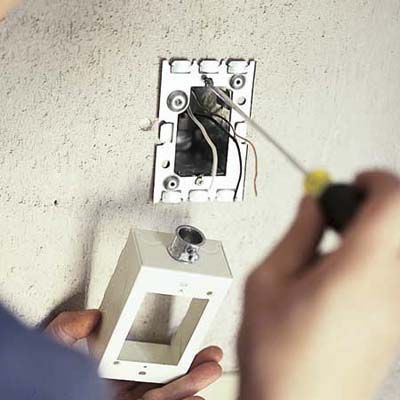
If you’re tapping into an existing outlet, you’ll need to install an extension box:
- Remove the cover plate from the existing outlet.
- Attach the metal mounting plate of the extension box to the existing electrical box.
- Use a screwdriver to remove the knock-out plug from the top of the extension box.
- Attach a 1/2-inch metal conduit connector to the top of the box.
- Fasten the extension box to the mounting plate using the provided screws.
Connecting the Conduit
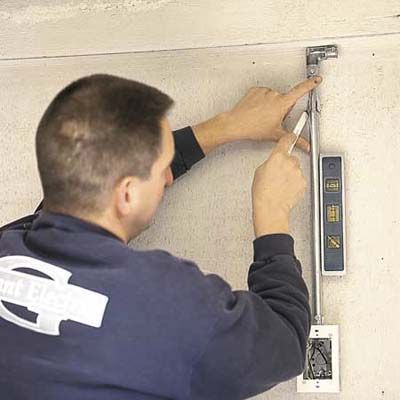
The conduit protects the wiring and provides a professional finish. Here’s how to connect it:
- Measure from the top of the extension box to the ceiling, subtracting 1 1/2 inches.
- Cut a piece of conduit to this length and file any sharp edges.
- Attach a right-angle connector to one end of the conduit.
- Insert the other end into the connector on the extension box.
- Use conduit hangers to secure the conduit to the wall, ensuring it’s plumb. Properly secured conduit maintains a neat and safe installation.
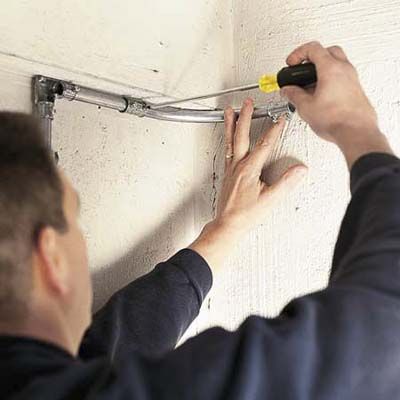
Running Electrical Wiring for a Garage Floodlight
Properly running electrical wiring through the conduit and making the necessary connections is essential for safe and effective operation.
Pulling Wires Through Conduit
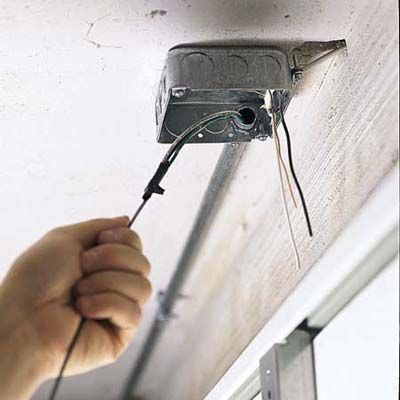
To run wires through the conduit, do the following:
- Feed an electrician’s fish tape into the conduit from the extension box.
- Push it through until it emerges at the other end.
- Attach one each of black, white, and green 14-gauge stranded copper wires to the fish tape using electrician’s tape.
- Carefully pull the fish tape back, drawing the wires through the conduit. This step requires patience to avoid damaging the wires.
- Leave about 6 inches of wire extending from each end of the conduit.
Making Proper Wire Connections
Once the wires are in place, take these steps:
- Trim the cable coming from the round outlet box to 6 inches and use a utility knife to cut away the plastic sheathing.
- Use wire strippers to remove 1/2 inch of the plastic insulation from the black and white wires.
- Join the cable to the garage light.
- Attach the garage light with machine screws and insert bulbs.
- Make the wire connections at the junction box and switch.
Mounting and Connecting the Floodlight
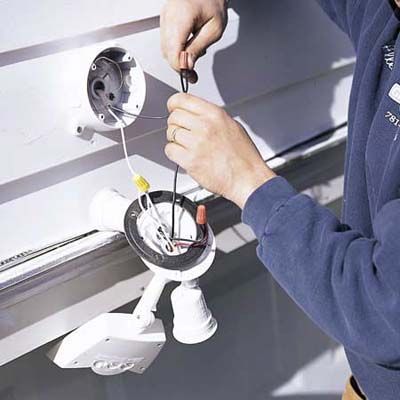
With the wiring in place, you’re ready to mount the floodlight and make the final connections, which will bring your project near completion.
Attaching the Floodlight to the Wall
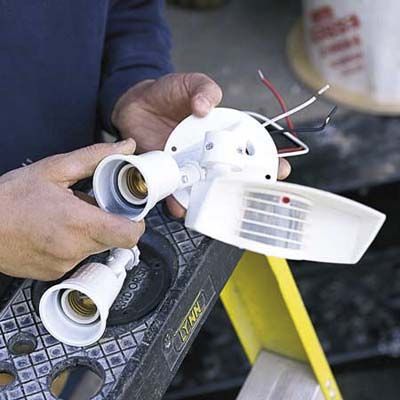
Here’s how to mount the floodlight:
- Hold the mounting bracket against the wall and mark the screw holes. Accurate marking ensures a level and stable installation.
- Drill pilot holes at the marked locations.
- If mounting on siding, use a mounting block for a secure, level surface.
- Attach the mounting bracket to the wall using weatherproof screws.
- Connect the floodlight to the mounting bracket according to the manufacturer’s instructions.
Wiring the Floodlight to Power Source
Here’s how to connect the floodlight to power:
- Feed the wires from the conduit through the floodlight’s base.
- Connect the black wire from the conduit to the black wire on the floodlight.
- Connect the white wire from the conduit to the white wire on the floodlight.
- Connect the green ground wire to the green wire or grounding screw on the floodlight.
- Secure all connections with wire nuts and wrap with electrical tape.
- Carefully tuck all wires into the floodlight base.
Adjusting and Testing the Floodlight
After installation, adjust and test your new floodlight to ensure it works as intended. This includes setting the motion sensor sensitivity and aiming the light fixtures for optimal coverage.
Setting Motion Sensor Sensitivity
Most motion sensor floodlights allow you to adjust their sensitivity:
- Locate the sensitivity control on your floodlight (usually a dial or switch).
- Start with the sensitivity set to medium. This provides a balanced starting point.
- Test the sensor by walking in the detection zone at various distances.
- Adjust the sensitivity as needed to avoid false triggers or missed detections. Fine-tuning ensures reliable operation.
- Consider factors like pets or passing cars when setting sensitivity. This prevents unnecessary activations.
Aiming the Light Fixtures
You’ll also need to aim the light to illuminate the areas you want. Here are some tips:
- Loosen the adjustment screws on the light fixtures.
- Aim the lights to cover the desired area, typically angled slightly downward. Downward angles reduce light pollution.
- Avoid aiming lights directly at neighbors’ windows or the street.
- Tighten the adjustment screws once the desired position is achieved.
- Test the coverage at night and make further adjustments if necessary. Night testing provides a real-world evaluation of the floodlight’s effectiveness.
Troubleshooting Common Garage Floodlight Issues
Even with careful installation, you may encounter some issues with your new floodlight. Here’s how to address common problems.
Dealing with Faulty Sensors
If your motion sensor isn’t working correctly:
- Check for obstructions in front of the sensor. Obstructions can block the sensor’s view.
- Adjust the sensor’s field of view if it’s triggering too often or not enough. Proper alignment improves reliability.
- Clean the sensor lens with a soft, damp cloth. Dirt or debris can interfere with sensor operation.
- Ensure the sensor isn’t exposed to direct sunlight, which can interfere with its operation. Sunlight can cause false triggers.
Addressing Wiring Problems
For issues related to wiring:
- Double-check all wire connections to ensure they’re secure and correct. Loose connections can cause malfunctions.
- Verify that the circuit breaker is on and hasn’t tripped. A tripped breaker cuts off power.
- Test the outlet with a voltage tester to confirm power is reaching the fixture. No power indicates a need for further investigation.
- If problems persist, consult a licensed electrician to inspect the wiring.
Maintaining Your Garage Floodlight
Regular maintenance will keep your garage floodlight working efficiently and help it last longer.
Regular Cleaning and Inspection
To keep your floodlight in top condition, do the following:
- Clean the light fixtures and sensor lens every few months with a soft, damp cloth.
- Check for any signs of water ingress or damage to the housing. Addressing issues early prevents further damage.
- Ensure all mounting screws and electrical connections remain tight.
- Trim any vegetation that may have grown to obstruct the sensor or lights. Clear paths maintain effective sensor functionality.
Replacing Bulbs and Components
When replacement is necessary, take these steps:
- Always turn off power before replacing bulbs or components. Safety should be the first priority.
- Use bulbs of the correct wattage and type as specified by the manufacturer.
- Consider upgrading to LED bulbs for improved energy efficiency and longevity.
- Replace the entire fixture if it shows signs of significant wear or damage.
Enhancing Security with Additional Features
While a floodlight significantly improves your garage’s security, you can make it even more effective by integrating it with other security measures. Here are some ideas.
Integrating with Smart Home Systems
Many modern floodlights can be connected to smart home systems. Here’s how to use one:
- Choose a smart floodlight compatible with your existing home automation platform.
- Set up schedules for your lights to turn on and off at specific times.
- Use smartphone apps to control your floodlights remotely.
- Create custom routines, such as having lights turn on when you arrive home.
Adding Cameras or Alarms
For additional security, consider adding a security camera.
- Look for floodlight models that come with built-in cameras and two-way audio. Combined units simplify installation and use.
- Connect your floodlight to a home security system for integrated protection.
- Set up alerts on your smartphone for any detected motion or activations.
